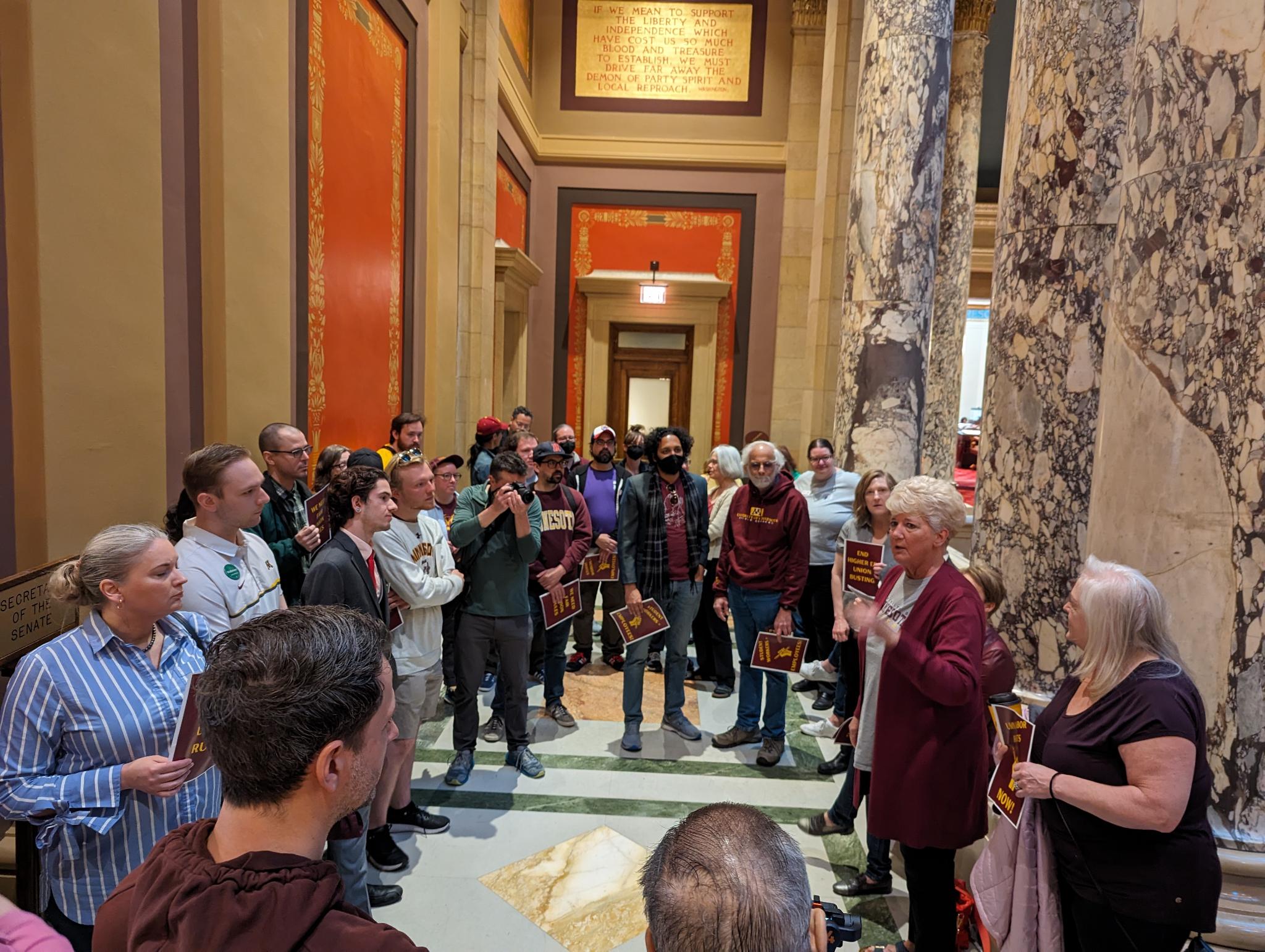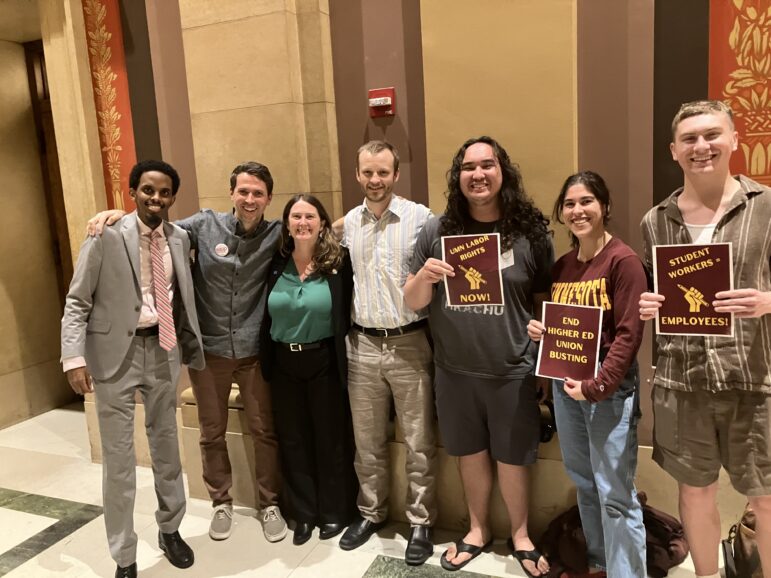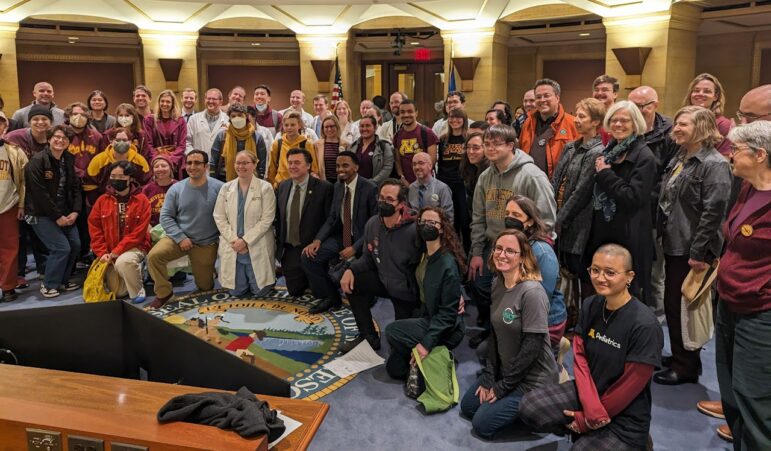
UMN workers and allies gather at the Minnesota State Legislator during their effort to reform PELRA.

Share
“If you don’t have a union and you want one, the door’s open,” invites Tracey Blasenheim, a University of Minnesota (UMN) lecturer and instructor in political science, after a successful organizing drive to reform a decades-old state law that predefines bargaining units for public employees. The reform effectively enables over 23,000 workers to form unions across the University of Minnesota’s five campuses. The reforms will go into effect on July 1.
The Public Employment Labor Relations Act, or PELRA, is the law that gives public sector (government) workers the right to organize unions and engage in collective bargaining in Minnesota. PELRA includes predefined bargaining units, or groups of employees that are allowed to form unions together for some job classes at the UMN (in the private sector, bargaining units are determined on a case-by-case basis for each new group of workers seeking union representation by the National Labor Relations Board, with input from unions and employers).
PELRA’s predefined bargaining units were ostensibly established in order to deter small, sporadic bargaining units of employees at the University of Minnesota. However, critics of the law argue that PELRA predefined the university’s bargaining units into large, convoluted bargaining units, where workers lack the typical “community of interest” that defines other bargaining units in the private and public sectors (e.g., many adjunct lecturers were in the same bargaining unit as the university’s highly compensated Director of Athletics). The 2024 reform did away with the most convoluted predefined bargaining units, therefore making organizing more realistic for job classes across the university.

Jackson Kerr
UMN workers and Sen. Omar Fateh and Sen. Jennifer McEwen at the Minnesota State Capitol holding up signs that read “End higher ed union busting” and “Student Workers = Employees”.According to a press release from UMN Labor Rights Coalition issued on May 20, “Thousands of UMN employees had been trapped in ‘gerrymandered’ bargaining units that made unionization effectively impossible.” The press releases continues, “Until now, PELRA had barred thousands of UMN employees from unionizing with their actual co-workers yet had required anyone who wanted a union to organize with workers performing entirely different jobs often hundreds of miles away.”
The reform also addressed many loopholes within PELRA that impacted various categories of workers, including student workers who received financial aid from the university, part-time employees, workers who received payment via stipend, and workers who received fellowships, amongst others. Blasenheim explained that for some graduate fellows and postdocs, their union eligibility status would “bounce between having union rights or not having union rights based on who signs the paycheck.”
While the reform does not have an immediate effect for most workers, some workers will see an immediate change, including graduate workers who previously fell into loopholes that kept them from unionization, who now will be eligible to join the University of Minnesota Graduate Labor Union (UMN-GLU).
Existing unions on campus, such as the Teamsters 320 and AFSCME 3800 will also see immediate change, as PELRA previously limited the outer limits of who they could organize. Over the years, some positions that were reclassified out of bargaining units have the opportunity to rejoin.
The PELRA reform movement had the support of existing unions on campus including Teamsters 320 and AFSCME 3800. They also had the support of other unions including the SEIU Minnesota, and Education Minnesota, Inter Faculty Organization, the Minnesota State College Faculty union, and the Minnesota AFL-CIO, which adopted a resolution in December 2023 to support the PELRA reform effort.
The decades-long fight to reform PELRA
The origins of this drive to reform PELRA were initially scattered across various groups of frustrated workers at the university. This included graduate workers who felt they were arbitrarily ineligible for UMN-GLU, medical residents, contingent faculty with the American Association of University Professors (AAUP), and legal student workers. Blasenheim explained that these groups all came together through the summer and fall of 2023 to organize for their common interests of reforming PELRA. At the outset, the group of organizers assumed the organizing effort would take more time to achieve reform.
The PELRA reform passed as a part of a broader omnibus bill that included legislation on labor, housing, and transportation. The bill was passed in the Senate, but then delayed in the House when the university submitted a budgetary note, which PELRA reform advocates and legislators say was massively inflated.
In a letter sent on April 29 to the Legislative Budget Office (LBO) from Sen. Omar Fateh and Sen. Jennifer McEwen, the senators ask that the LBO reconsider the fiscal note, describing it as a “disguised budget request” and “entirely inappropriate.”
The letter goes on to detail the university’s “implausible” line items including the addition of four labor relations staff, with yearly salaries ranging from $140,000 to $170,000. The letter states, “Although the University currently covers 11 bargaining units with 2 full-time labor relations staff, the note claims it would need 4 additional full-time labor relations staff to cover just 5 more bargaining units.” Other costs included $522,000 to implement an evaluation system and $142,000 to create seniority rosters for five bargaining units.
Workday Magazine contacted the University of Minnesota for comment, but did not receive a response by deadline.
After the note was reviewed, the legislature determined that PELRA reform would not cost nearly the amount that the university stated, and the bill was then passed during reconciliation.
This is not the first attempt to organize more workers on campus and reform PELRA at the University of Minnesota. In 2016, when faculty at the university attempted to unionize and as a part of the organizing drive, workers sought to amend PELRA through the Bureau of Mediation Services. However, the University of Minnesota then filed and won a lawsuit, reaffirming the bargaining unit structure established by PELRA.
This reform is coming off the heels of the University of Minnesota graduate student workers winning their union in the beginning of 2023. After many attempts over the decades, graduate workers won their union in April 2023 and are currently bargaining their first contract.
Workers at the University of Minnesota are the largest group of non-unionized public workers in Minnesota, presenting an opportunity for future organizing.
A Bargaining Unit of One’s Own
One notable group that PELRA reform opened for organizing is contingent faculty, or faculty who work on short-term contracts, as distinct from tenured faculty. These contingent faculty’s job classifications can have them spread across different job designations, and previously PELRA made it so that contingent staff could not form a bargaining unit of their own. Contingent faculty make up a significant and rising proportion of all faculty at the university..
William Jones, history professor at the University of Minnesota, Twin Cities, is one of the faculty involved in the movement to reform PELRA. Jones explains that under PELRA, contingent faculty are in a bargaining unit that is a “hodgepodge of workers” that includes librarians, IT workers, and athletic staff. Under the law as it was, contingent faculty would need to organize into two different bargaining units, Jones explains.
PELRA was not formed during a time when the university was relying on the high levels of contingent and adjunct faculty seen today. Jones adds, “The university benefits from the way in which the bargaining units are drawn now [pre-reform], and they benefit from having the contingent faculty divided into two bargaining units. That makes it almost impossible to organize contingent faculty.”

Jackson Kerr
UMN workers and other PELRA advocates pose for a photo together at the Minnesota State Capitol.Heather Holcombe is a lecturer in the Department of English and the vice president of the Twin Cities chapter of the American Association of University Professors. Holcombe began teaching classes at the U in 2018 “on a very piecemeal basis, a typical situation for contingent faculty.” She explains, “Currently, there is no path to tenure track” for someone in Holcombe’s position.
“We have roughly 1,100 contingent faculty and some of us are paid as little as $6,000 to teach a class. So if we’re teaching full time, that would be six classes a year, that means people are making $38,000 a year.” When coupled with years of experience, education, training, and research, Holcombe argues this is not sufficient. “People who have Ph.D.s, people who have terminal degrees in their field, people who have a decade of experience, are making less than half of what they could make if they were an underpaid public educator in the K through 12.”
Along with the low pay, the contingent faculty are left scrambling over the summer to pay for their own health insurance, which many contingent faculty struggle to cover, Holcombe said.
The contract work is also not secure from year to year. Many contingent faculty work on yearly contracts with no guarantee they will still have a job a few months in the future. “What the structure of the contract does is also make it possible to fire people without calling it a firing, because it is simply presumed that you won’t be asked back,” Holcombe explains. “And so people can be let go at any time and they are owed no explanation at all.”
Many educators argue this structure hurts the overall academic freedom on university campuses, which is not only damaging to the professors as a workplace concern, but also creates a weaker learning environment for students.
Holcombe argues that these protections “can be life-changing in the ways that those faculty then can engage with and empower their students, by being a steady presence on a campus where they have opportunity to develop deep institutional knowledge, long-term relationships with students and real opportunities to contribute to the intellectual and curricular life of the university.”
Undergraduate student workers
Another key sector of workers who the PELRA reform will impact is undergraduate student workers. Under the previous iteration of PELRA, undergraduate workers who received financial aid were not eligible to organize a labor union. Blasenheim commented on the absurdity of the stipulation, saying that “Working-class students have fewer labor rights than wealthy students.”
“The law that we just changed said that you can join a union if you’re an undergrad worker, but only if you don’t need financial aid, which is 70% of all undergraduates,” Blasenheim added. “You clearly have a huge issue of inequity and discrimination against working-class students.”
Aidan Thomsen is an undergraduate student at the University of Minnesota, Twin Cities and was involved in the PELRA reform coalition. Thomsen is an incoming senior who receives financial aid and work study from the university, and according to the previous PELRA law, would not have had the right to form a union.
When first learning about the legal stipulations against students like him being able to join a union, Thomsen describes feeling “shocked.” He added, “It’s so blatantly discriminatory…People from lower economic backgrounds had less rights as a student worker than other student workers.”
While organizing other student workers, Thomsen shared that it was easy to get other students on board because of the blatant unfairness of the law. Not only were students supportive, he shared, but also student government and other student organizations, including Black Motivated Women, Mi Gente Latinx Student Cultural Center, the Queer Student Cultural Center, and the Minnesota International Student Association.
“There’s a lot of momentum,” Thomsen says, pointing to Macalester College student workers organizing and University of Oregon undergraduate student worker union, one of the largest in the country.
Undergraduate student organizing is not unprecedented in Minnesota. Across the Mississippi River in St. Paul, Macalester College’s Undergraduate Workers’ Union announced their union drive in February 2024.
What’s next?
When asked what’s next, there’s buzz and optimism across the workers interviewed by Workday Magazine, however, there are no public organizing drives yet. Holcombe shares this excitement for contingent faculty and what this moment means: “There is a viable path forward, an exciting one, which is that contingent faculty now have a right that they didn’t have before, which is that they can decide how they want to organize, if they want to organize, who they want to organize with, and what they want the outcomes of that organizing to look like.” She adds, “I think there’s a real sense of possibility right now on the table.”
Amidst the possibility, Blasenheim adds that is not just to improve pay and conditions for university workers, it can also be an opportunity to “democratize” the university more broadly to better reflect the interests of its workers, students, and community members.
Jones agrees that organized labor could support and better represent the university’s public perception.“If the only thing you know about the U is what you read in the news, the President’s salary, the football coach’s salary, you’ll think, ‘They’re doing fine, right? They’re paying people over a million dollars.’ But you don’t actually see what most people at the U are earning.”
With a more organized workforce that speaks for itself, Jones argues that faculty will give the public and the legislature a more realistic view of the conditions of workers at the university and can then better advocate for more funding. “Having the faculty organized to represent our own interests and speak truthfully to our own situation, that can actually benefit you politically, in ways that I don’t think the administration really appreciates.”
Blasenheim describes the current climate on campus of an increasingly corporatized public university—exhibited by highly paid administrators, undergraduate students as customers, tiered labor, and prioritizing financial incentives over academic and research needs, all situated in “a hierarchical structure where people at the top have made huge salaries, and everyone else gets squeezed.”
He adds, “This is your moment to change. We have actual fair rules for joining and forming bargaining units now and we have incredible momentum. There has never ever been a better time to organize.”
Disclosure: Isabela Escalona is a Professional & Administrative (P&A) employee of the University of Minnesota. Along with UMN faculty and student employees, P&A employees are impacted by the changes to PELRA described in this article. Workday Magazine is a publication of the Labor Education Service based at the University of Minnesota.

